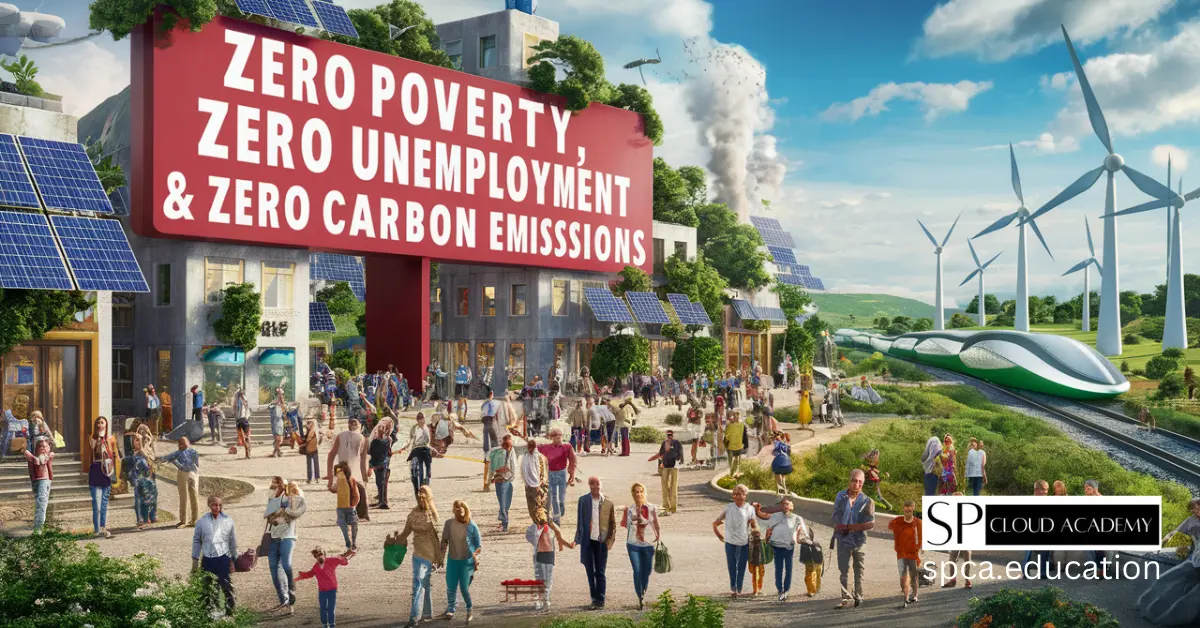In today’s world, humanity faces unprecedented challenges: widespread poverty, rising unemployment, and the escalating threat of climate change. Enter the 3-0 Initiative, a visionary framework designed to tackle these issues head-on by aiming for zero poverty, zero unemployment, and zero carbon emissions. This ambitious plan isn’t just a collection of lofty ideals—it’s a practical blueprint for creating a sustainable, equitable, and prosperous future. But what exactly is the 3-0 Initiative, and how can achieving these three goals transform our world?
In this comprehensive, article, we’ll explore the 3-0 Initiative in depth. We’ll break down each component—zero poverty, zero unemployment, and zero carbon emissions—examine their interconnections, and highlight the strategies, challenges, and real-world examples that bring this vision to life.
What is the 3-0 Initiative?
The 3-0 Initiative is a bold, global framework that sets out to achieve three transformative goals:
- Zero Poverty: Eradicating poverty in all its forms, ensuring every individual has access to basic needs like food, shelter, healthcare, and education.
- Zero Unemployment: Building an economy where everyone who wants to work can find meaningful, well-paying jobs.
- Zero Carbon Emissions: Transitioning to a carbon-neutral world by eliminating net carbon emissions to combat climate change.
The name “3-0” reflects the target of reducing these three critical issues to zero. Unlike other frameworks that aim for incremental progress, the 3-0 Initiative pushes for complete eradication, making it both ambitious and revolutionary. It’s not about addressing these problems in isolation; it’s about recognizing their interconnectedness and tackling them holistically through integrated social, economic, and environmental strategies.
Why the 3-0 Initiative Matters
The stakes couldn’t be higher. Over 700 million people live in extreme poverty, unemployment is a growing concern in many regions, and carbon emissions continue to drive climate change, threatening ecosystems and human livelihoods. The 3-0 Initiative matters because it offers a comprehensive solution to these intertwined crises. By achieving its goals, we could create a world where:
- Every person lives with dignity and opportunity.
- Economies flourish without exploiting people or the planet.
- The environment is safeguarded for future generations.
This initiative aligns with global efforts like the United Nations Sustainable Development Goals (SDGs)—specifically SDG 1 (No Poverty), SDG 8 (Decent Work and Economic Growth), and SDG 13 (Climate Action)—but takes a more audacious stance by targeting zero in each area.
Zero Poverty: A World Without Deprivation
Understanding Poverty
Poverty isn’t just about a lack of money; it’s a multidimensional issue that affects every aspect of life. Key dimensions include:
- Income Poverty: Surviving on less than $1.90 per day, the World Bank’s extreme poverty threshold.
- Lack of Access: No access to essentials like healthcare, education, clean water, or sanitation.
- Social Exclusion: Marginalization due to gender, race, ethnicity, or disability, limiting opportunities.
- Vulnerability: Exposure to risks like natural disasters or economic downturns without safety nets.
Achieving zero poverty means addressing all these facets, ensuring no one is left behind.
Strategies to Achieve Zero Poverty
To eradicate poverty, we need systemic, actionable strategies. Here are some key approaches:
- Equitable Resource Distribution
- Implement progressive taxation and wealth redistribution to narrow the income gap.
- Establish social safety nets like welfare programs to support the most vulnerable.
- Universal Basic Income (UBI)
- Provide a guaranteed income to every citizen to cover basic needs, reducing poverty risks.
- Pilot programs in places like Finland and Kenya show promising results.
- Access to Education and Healthcare
- Invest in free or affordable education to break the poverty cycle.
- Ensure universal healthcare to reduce medical debt and improve quality of life.
- Economic Empowerment
- Create targeted programs for marginalized groups—women, minorities, and people with disabilities.
- Offer microfinance and skills training to foster entrepreneurship.
- Sustainable Agriculture and Food Security
- Support small-scale farmers with resources and sustainable practices.
- Ensure access to nutritious food to combat hunger and malnutrition.
The Impact of Zero Poverty
Imagine a world where no one goes hungry, every child attends school, and healthcare is a universal right. The benefits of zero poverty include:
- Improved Health: Lower rates of malnutrition, infant mortality, and preventable diseases.
- Economic Growth: A healthier, educated population drives productivity and innovation.
- Social Stability: Reduced inequality fosters peace and cohesion.
Zero Unemployment: Full Employment for All
Understanding Unemployment
Unemployment goes beyond joblessness—it’s about the underutilization of human potential. Types of unemployment include:
- Cyclical: Job losses during economic recessions.
- Structural: Skills mismatches with job demands.
- Frictional: Temporary unemployment during job transitions.
- Hidden: People who’ve stopped looking for work or are underemployed.
Achieving zero unemployment means ensuring everyone who wants to work has access to meaningful employment.
Strategies to Achieve Zero Unemployment
Creating a full-employment economy requires innovation and investment. Here’s how:
- Job Creation Through Green Technologies
- Invest in renewable energy, sustainable infrastructure, and green industries.
- The International Labour Organization estimates green jobs could create 24 million positions by 2030.
- Education and Skills Training
- Reform education to focus on future-ready skills like STEM, digital literacy, and vocational training.
- Offer lifelong learning programs to adapt to changing job markets.
- Entrepreneurship and Innovation
- Provide grants, loans, and mentorship to startups and small businesses.
- Foster innovation hubs to drive economic growth.
- Public Works Programs
- Launch large-scale projects (e.g., infrastructure development) to employ people during downturns.
- Historical examples like the New Deal in the U.S. show their effectiveness.
- Flexible Work Arrangements
- Promote remote work, part-time roles, and gig opportunities to suit diverse needs.
The Impact of Zero Unemployment
A world with zero unemployment would unlock immense potential:
- Maximized Human Contribution: Everyone contributes to society, boosting innovation.
- Economic Stability: Full employment increases consumer spending and reduces welfare costs.
- Social Well-being: Jobs provide purpose, dignity, and community.
Zero Carbon Emissions: A Sustainable Planet
Understanding Carbon Emissions
Carbon emissions, mainly from fossil fuels, are the primary driver of climate change. They cause:
- Global Warming: Rising temperatures disrupt weather, leading to floods, droughts, and hurricanes.
- Ocean Acidification: Damages marine ecosystems.
- Air Pollution: Harms human health with respiratory and cardiovascular issues.
Achieving zero carbon emissions means reaching net-zero emissions through sustainable practices and renewable energy.
Strategies to Achieve Zero Carbon Emissions
Here’s how we can transition to a carbon-neutral world:
- Renewable Energy Transition
- Shift to solar, wind, hydro, and geothermal energy sources.
- Countries like Germany and Iceland lead with high renewable energy adoption.
- Electrification of Transportation
- Promote electric vehicles (EVs) and expand public transit.
- Reduce emissions from cars, a major pollution source.
- Energy Efficiency
- Use energy-saving technologies in buildings, industries, and appliances.
- Retrofit homes and offices to lower energy consumption.
- Carbon Capture and Storage (CCS)
- Develop technologies to capture and store industrial emissions.
- Emerging solutions show promise but need scaling.
- Sustainable Agriculture and Forestry
- Implement reforestation and regenerative farming to sequester carbon.
- Reduce emissions from livestock and land use.
The Impact of Zero Carbon Emissions
A zero-carbon world would yield transformative benefits:
- Climate Stability: Fewer extreme weather events and stabilized temperatures.
- Healthier Populations: Reduced air pollution lowers disease rates.
- Biodiversity Protection: Ecosystems thrive, preventing species loss.
The Synergy Between the Three Zeros
The true power of the 3-0 Initiative lies in the interconnection of its goals. Here’s how they reinforce each other:
- Zero Poverty and Zero Unemployment:
- Eradicating poverty creates a skilled workforce, reducing unemployment.
- Full employment provides income, lifting people out of poverty.
- Zero Unemployment and Zero Carbon Emissions:
- Green industries create jobs while cutting emissions.
- Employment in sustainability sectors accelerates the carbon transition.
- Zero Poverty and Zero Carbon Emissions:
- Poverty programs can include clean energy access, reducing emissions.
- A stable climate protects vulnerable communities from environmental shocks.
This synergy creates a virtuous cycle, where progress in one area fuels success in the others.
Challenges and Obstacles
The 3-0 Initiative is ambitious, and achieving it faces significant hurdles:
- Political Will
- Requires global cooperation and strong leadership, often lacking in divided political climates.
- Economic Costs
- Transitioning to zero carbon and funding poverty/unemployment programs demands massive investment.
- Vested Interests
- Fossil fuel industries and exploitative labor practices resist change.
- Technological Barriers
- Scaling renewable energy and carbon capture tech requires rapid advancement.
- Social Resistance
- Changing behaviors (e.g., reducing car use) and mindsets is challenging.
Despite these obstacles, the benefits—economic, social, and environmental—make the effort worthwhile.
Real-World Examples and Case Studies
Countries and initiatives worldwide are already aligning with the 3-0 vision:
- Denmark: Aims for carbon neutrality by 2050, with robust welfare reducing poverty and unemployment.
- Costa Rica: Nearly 100% renewable energy and extensive reforestation efforts.
- Bhutan: Prioritizes Gross National Happiness, balancing development and sustainability.
- Green New Deal (U.S.): A proposed framework linking climate action with economic equity.
These examples prove that the 3-0 goals are achievable with commitment and innovation.
The Role of Technology and Innovation
Technology is a game-changer for the 3-0 Initiative:
- Artificial Intelligence (AI): Optimizes energy use, boosts agriculture, and creates jobs.
- Blockchain: Ensures transparency in sustainable supply chains.
- Renewable Tech: Advances in solar and wind make clean energy affordable.
- Biotechnology: Enhances carbon sequestration and sustainable farming.
Investing in R&D is critical to overcoming technical challenges.
The Role of Individuals and Communities
You don’t need to be a policymaker to contribute:
- Consumer Choices: Buy sustainable products and reduce waste.
- Community Action: Start local projects like renewable energy co-ops or skill-sharing.
- Advocacy: Push for policies supporting the three zeros.
Every step counts toward the bigger goal.
Conclusion: A Vision for the Future
The 3-0 Initiative is more than a set of targets—it’s a vision for a world where poverty is history, everyone has meaningful work, and the planet thrives. Achieving zero poverty, zero unemployment, and zero carbon emissions won’t be easy, but it’s possible with bold leadership, global collaboration, and collective action. This isn’t just a dream; it’s a roadmap to a sustainable, equitable future. Let’s embrace it and turn vision into reality.
FAQs
- What is the 3-0 Initiative?
A framework targeting zero poverty, zero unemployment, and zero carbon emissions. - How can we achieve zero poverty?
Through equitable resources, UBI, education, healthcare, and sustainable agriculture. - What strategies reduce unemployment to zero?
Green tech jobs, skills training, entrepreneurship, public works, and flexible work. - How do we reach zero carbon emissions?
Via renewables, electrification, efficiency, carbon capture, and sustainable practices. - Why are the goals interconnected?
Progress in one (e.g., poverty) boosts others (e.g., employment, emissions). - What are the main challenges?
Political will, costs, vested interests, tech barriers, and social resistance. - Can individuals help?
Yes, through sustainable choices, community efforts, and advocacy. - Which countries are leading the way?
Denmark, Costa Rica, and Bhutan are notable examples. - How does technology support the initiative?
AI, blockchain, and renewables drive progress across all three goals. - Is the 3-0 Initiative realistic?
Yes, with commitment, innovation, and cooperation, it’s within reach.
See Also
-

Lifelong Learning in the AI Era: How Upskilling Can Future-Proof Your Career
-

Welcome to the Future: 10 Intelligent Home Devices Transforming Your Home
-

Top 10 Travel Vlogs to Fuel Your Wanderlust
-

Wanderlust Wonders: The 10 Best Travel Blogs That Will Inspire Your Next Adventure
-

Biological Birth Vs Personality: What Really Shapes Who You Are?
-

The 3-0 Initiative Explained: How Zero Poverty, Zero Unemployment & Zero Carbon Emissions Can Change the World
-

E-Governance Explained: How Technology is Empowering Citizens Like Never Before
-

Sustainable Living Made Easy: Small Changes with a Big Impact
-

Transform Your Life: Ultimate New Year Planning Guide for a Fresh Start